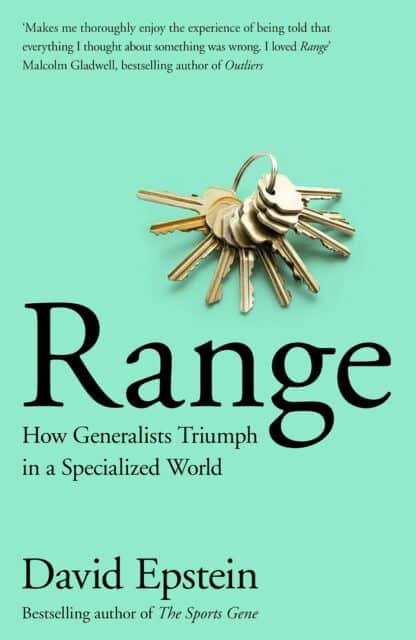
Review of Range by Richard Schulman
David Epstein’s recently published book, Range: Why Generalists Triumph in a Specialized World (New York: Riverhead Books, 2019), provides an important corrective to Malcolm Gladwell’s 2008 book, Outliers: The Story of Success. Outliers argued that the road to great success begins with early commitment to a specialization and 10,000 hours of practice in it. While author Epstein does not come out altogether against specialization, he gives numerous examples from sports, business, science, and the arts as to how exploration and familiarity with various fields and delayed commitment to specialization is common among high achievers, as is also career switching later in life.
Accordingly, one major aspect of Range is its emphasis on the importance of match quality – picking the profession that is the best fit for one’s talents and motivations after exploring different sports, musical instruments, and occupations while young or later. Not hesitating to quit a field that one is either not good at or doesn’t like comes into much praise by the author. For this reason, Range is skeptical of pushing children into early commitment to a particular skill, as in Amy Chua’s 2011 book, Battle Hymn of the Tiger Mother.
Epstein cites Vincent van Gogh as a counter-example to the Outliers paradigm. Van Gogh failed in one endeavor after another but kept moving on, ultimately finding his place as an extraordinarily innovative painter. The author could have mentioned Ulysses A. Grant as another example of a serial failure who ultimately made good.
Range also notes that the learning that accompanies the earlier failures often contributes in unexpected ways to the later successes.
After finishing range, this review reflected that although most mass shooters in the US in recent decades have been mentally ill or jihadists or both, several were school or career failures who would have done better taking their lumps and moving on to a different major or career direction. This is useful knowledge that should be imparted in secondary school hygiene classes, along with diet, basic financial skills, the importance of exercise, basic social skills, and relational skills with the opposite sex.
Another important insight of Range is the superiority of slow learning – in which the student must reach to master a concept and be faced with challenges to integrate it with other concepts and apply it to distant problems (interleaving). This is in contrast to fast learning where the student receives constant tips and hints so that the idea is learned quickly but with narrow application (i.e., low transferability) and low retention. Interestingly, the author cites studies that show that in their evaluations of teachers, students wrongly prefer the easy (“fast”) teachers to the hard (“slow”) ones.
Transferability of knowledge, Range suggests, is nourished by wide interests, multiple experiences, and bringing an outsider’s or child’s playful attitude to problems requiring new solutions. Rigid, hierarchical institutions are inimical to such creativity. The author’s textbook example is NASA, where a rigid enforcement of engineers’ penchant for data became a ruling dogma, leading to the Challenger disaster and, nothing learned, a repeat performance with the Columbia. In both cases, premonitions of unacceptable risk before the launches were repressed because unsupported by the hard data the engineering culture demanded.
It’s not surprising that the private sector (J. Craig Venter’s Celera and Elon Musk’s SpaceX), despite much smaller resources, left the government-bureaucracy-encumbered Human Genome Project and NASA in the dust. Meanwhile NASA seems to be doubling down on the wasted billions and years it devoted to the International Space Station with a new white elephant, the Lunar Gateway.
Favorable reviews of Range have also appeared in The Atlantic, New York Times, Wall Street Journal, Quartz, and Kirkus.

Leave a Reply